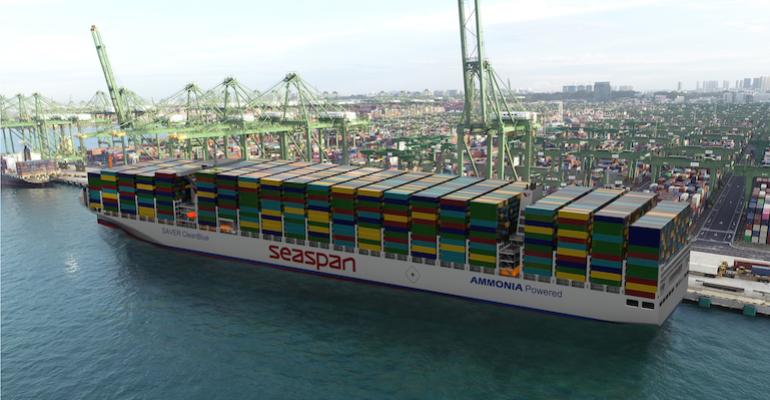According to Seaspan Ship Management’s Seb Brindley, Senior Naval Architect involved in the project for the last two years, there has been a steady stream of enquiry since the design received Approval in Principle from the American Bureau of Shipping in August.
The company’s liner-operating clients are currently assessing several future fuels, Brindley told Seatrade Maritime News recently, but ammonia seems to be a favoured option amongst a number of lines considering its scalability by 2050.
Of course, there are no large two-stroke ammonia-fuelled engines available as yet, but MAN Energy Solutions completed successful combustion testing of an ammonia-powered unit at its Research Centre Copenhagen earlier this year and expects to have large two-stroke dual-fuelled ammonia engines available commercially from 2026.
The principal dimensions, tank configuration, and general arrangement of the 15,000 teu ammonia-fuelled container has been based on Seaspan’s 23 container ships of the same size from three different vessel series. Two are ship classes using conventional fuels and incorporating the latest hull optimisation and energy saving devices; the third is an LNG dual-fuelled design with the first of these, the Zim Sammy Ofer, delivered in April 2023.
The design process has thrown up both opportunities and challenges, Brindley said, citing safety benefits through fully refrigerated ammonia storage, for example, and optimising the location and size of ammonia fuel tanks to minimise the loss of cargo slot capacity and the risk of tank penetrations. Providing sufficient space for hazardous zones, separate spaces for ammonia-related equipment, and understanding the risks of ammonia leakage and possible dangers to ship personnel were other major considerations.
Seaspan and Brindley are now focusing on the next phase of the design process. These include but are not limited to:
- understanding the impacts of ammonia leakage and release scenarios to minimise risks to crew;
- understanding actual emissions profiles, pilot fuel requirements, and safety implications of ammonia dual-fuelled engines and associated equipment;
- the integration of other equipment and systems on board, including boil-off gas management, the ventilation of spaces containing ammonia equipment, the fuel supply system, and ammonia water solution storage and treatment.
Quite apart from the wide-ranging safety, operability, and endurance issues, Brindley emphasised the importance of the economic metric – cost per teu.
Part of this will be a result of the design efficiency of the ship, but key components in the operation of such vessels will include the price of ammonia as a marine fuel, whether or not it is ‘green’, and the fuel supply chain and sufficient availability in key locations. In this respect, container ships deployed in the world’s major liner trades are as good a place to start as any.
Copyright © 2024. All rights reserved. Seatrade, a trading name of Informa Markets (UK) Limited.
Add Seatrade Maritime News to your Google News feed.  |

